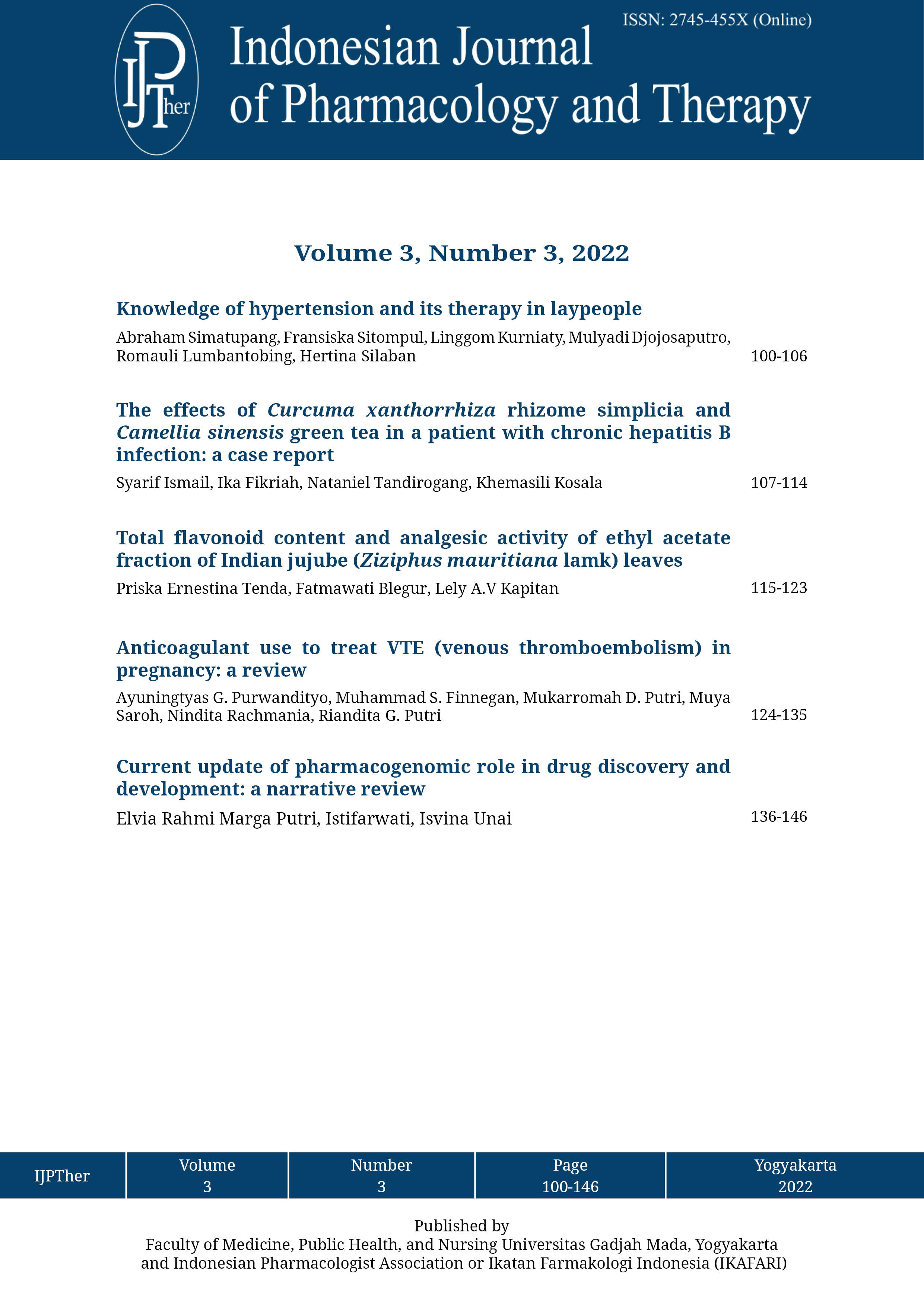Knowledge of hypertension and its therapy in lay people
Abstract
Hypertension is one of the non-communicable diseases that is becoming a global health problem. Hypertension can be identified by systolic blood pressure of 140 mmHg and diastolic 90 mmHg . Uncontrolled hypertension can lead to complications such as stroke, ischemic heart disease, heart attack, heart failure, kidney failure, blindness, etc. According to Basic Health Research 2018 ( Ris et Kesehatan Dasar 2018/Ris kesdas 2018) the prevalence of hypertension for >18 years old wa s 8.4%, and through measurements taken in health care facilities by 34.1%. Prevalence in the city was 34.4%, in the village was 33.7%, while according to gender 31.3% f or male and 36.9% for female. The study aimed to find out the knowledge and awareness of laypeople on hypertension and its therapy. This was a cross-sectional online study with 11 questions. Respondents were recruited from social media groups. The results showed 5 00 respondents (62.8 % female and 37.2 % male) involved in this study . The most common age range was 21-40 years (36.2 %), followed by 41-55 years (38.2%) , and the least was 56-65 years old (18.4%). Seventy-two percent of respondents did not have hypertension, and 9% said they did not know. Fifty-three percent of respondents knew about the value of high blood pressure, and 89% of the respondents said hypertension should be treated regularly. The most hypertension complications answered by respondents were stroke (40%), heart attack (26%) , and heart failure (16%). Amlodipine was the most mentioned by the respondents, and the second was ACE-inhibitor. However, omeprazole and omega-3 were also mentioned as anti-hypertension. Genetic s and a high salt diet were risk factors that many respondents chose. In conclusi on, the r espondents have a good understanding of hypertension. Information related to behaviour is needed to discontinue the increasing prevalence.
References
2. Laporan Nasional Riskesdas. Laporan_Nasional_RKD2018_FINAL.pdf [Internet]. Badan Penelitian dan Pengembangan Kesehatan. 2018. p. 198. Available from: http://labdata.litbang.kemkes.go.id/images/download/laporan/RKD/2018/Laporan_Nasional_RKD2018_FINAL.pdf
3. Cosimo Marcello B, Maria Domenica A, Gabriele P, Elisa M, Francesca B. Lifestyle and Hypertension: An Evidence-Based Review. J Hypertens Manag. 2018;4(1):1–10.
4. Valenzuela PL, Carrera-Bastos P, Gálvez BG, Ruiz-Hurtado G, Ordovas JM, Ruilope LM, et al. Lifestyle interventions for the prevention and treatment of hypertension. Nat Rev Cardiol. 2021;18(4):251–75.
5. Peacock E, Krousel-Wood M. Adherence to Antihypertensive Therapy. Med Clin North Am [Internet]. 2017;101(1):229–45. Available from: http://dx.doi.org/10.1016/j.mcna.2016.08.005
6. Burnier M, Egan BM. Adherence in Hypertension: A Review of Prevalence, Risk Factors, Impact, and Management. Circ Res. 2019;124(7):1124–40.
7. Jongen VW, Lalla-Edward ST, Vos AG, Godijk NG, Tempelman H, Grobbee DE, et al. Hypertension in a rural community in South Africa: What they know, what they think they know and what they recommend. BMC Public Health. 2019;19(1):1–10.
8. Egan BM, Bandyopadhyay D, Shaftman SR, Wagner CS, Zhao Y, Yu-Isenberg KS. Initial monotherapy and combination therapy and hypertension control the first year. Hypertension. 2012;59(6):1124–31.
9. Perhimpunan Dokter Hipertensi Indonesia. Konsensus Hipertensi. 2019;118. Available from: http://www.inash.or.id/upload/event/event_Update_konsensus_2019123191.pdf
10. Pirasath S, Kumanan T, Guruparan M. A Study on Knowledge, Awareness, and Medication Adherence in Patients with Hypertension from a Tertiary Care Centre from Northern Sri Lanka. Int J Hypertens. 2017;1–6.
11. Malik A, Yoshida Y, Erkin T, Salim D, Hamajima N. Hypertension-related knowledge, practice and drug adherence among inpatients of a hospital in Samarkand, Uzbekistan. Nagoya J Med Sci. 2014;76(3–4):255–63.
12. Hossain MM, Tasnim S, Sharma R, Sultana A, Shaik AF, Faizah F, et al. Digital interventions for people living with non-communicable diseases in India: A systematic review of intervention studies and recommendations for future research and development. Digit Heal. 2019;5:1–18.



